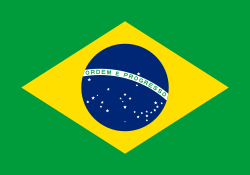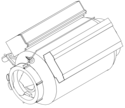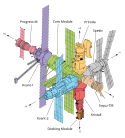Mir
- För andra betydelser, se Mir (olika betydelser).
| Mir Мир | |
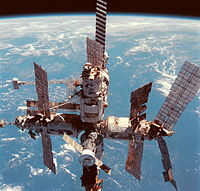 | |
| NSSDC-ID | 1986-017A[1] |
|---|---|
| Land | Sovjetunionen Ryssland |
| Anrop | Mir |
| Besättning | 3 st |
| Bemannad | 4 592 dagar |
| I omloppsbana | 5 510 dagar, 8 timmar[2] |
| Återinträde | 23 mars 2001, 05:59 UTC[2] |
| Uppskjutning | |
| Raket | Protonraket Space Shuttle |
| Uppskjutningsramp | Kosmodromen i Bajkonur LC-200/39 och LC-81/23 Kennedy Space Center LC-39 |
| Uppskjutning | 19 februari 1986, 21:28:23 UTC[2] |
| Mått | |
| Längd | 19 m |
| Bredd | 31 m |
| Höjd | 27,5 m |
| Massa | 129 700 kg |
| Beboelig volym | 350 m³ |
| Lufttryck | 101,3 kPa |
 | |
| Omloppsbanans egenskaper | |
| Banlutning | 51,6°[1] |
| Omloppstid | 91,9 min |
| Apoapsis | 374 km |
| Periapsis | 354 km |
| Varv | 86 330 st[2] |





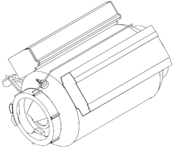

Mir (ryska: Мир, ’fred’, ’värld’) var en ursprungligen sovjetisk och senare rysk rymdstation. Stationen var den första att vara permanent bemannad.
Mir byggdes upp av moduler, som var och en sköts upp mellan 19 februari 1986 och 23 april 1996. Mirs uppgift var att fungera som ett vetenskapligt laboratorium i yttre rymden.
1995 genomfördes den första dockningen mellan en rysk rymdstation och en amerikansk rymdfärja.
23 mars 2001 brann rymdstationen upp då den avsiktligt återinträdde i jordens atmosfär efter ungefär 86 330 varv kring jorden. Rester av den slog ner i Stilla havet öster om Nya Zeeland.
Mirs moduler
Mir var uppbyggd av flera moduler.
| Dockningsport | |||||||||||||||||||||||||||||||||||||||||
| Kvant-1 | |||||||||||||||||||||||||||||||||||||||||
| Dockningsport | Kvant-2 | Spektr | |||||||||||||||||||||||||||||||||||||||
| Dockningsport | Dockningsmodul | Kristall | DOS-7 (Mir) | Priroda | |||||||||||||||||||||||||||||||||||||
| Dockningsport | |||||||||||||||||||||||||||||||||||||||||
| Modul | Uppskjutning | Raket | Dockning | Vikt | Ursprung |
|---|---|---|---|---|---|
| Mir (kärnan) | 19 februari 1986 | Proton-K | N/A | 20 100 kg | Sovjetunionen |
| Boendeutrymme | |||||
| Kvant-1 | 31 mars 1987 | Proton-K | 9 april 1987, 00:35:58[3] | 11 000 kg | Sovjetunionen |
| Gyroskop för stabilitet och utrustning för Astronomiska observationer | |||||
| Kvant-2 | 26 november 1989 | Proton-K | 6 december 1989, 12:21:28[4] | 19 640 kg | Sovjetunionen |
| Nyare, mer sofistikerade livsuppehållande system. | |||||
| Kristall | 31 maj 1990 | Proton-K | 10 juni 1990, 10:47:22[5] | 19 640 kg | Sovjetunionen |
| Teknologi-, materialbehandlings-, geofysik- och astrofysiklaboratorium | |||||
| Spektr | 20 maj 1995 | Proton-K | 1 juni 1995, 00:56:16[6] | 17 840 kg | Ryssland |
| Inhyste experiment tillhörande samarbetsprogrammet mellan USA och Ryssland. | |||||
| Dockningsmodul | 12 november 1995 | STS-74 Atlantis | 15 november 1995 | 6 134 kg | USA |
| Dockningsport för rymdfärjan. | |||||
| Priroda | 23 april 1996 | Proton-K | 26 april 1996, 12:42:32[7] | 19 000 kg | Ryssland |
| Modul för observation av jordytan och atmosfären inom frekvensområdena för mikrovågor, infraröd strålning och ljus. | |||||
Mir (kärnan)
Mir eller DOS-7 var den första delen av stationen, den sköts upp med en Protonraket den 19 februari 1986. Modulen har stora likheter med Saljut 6 och Saljut 7. Totalt hade modulen 6 dockningsportar, 5 i fronten och en i aktern. I aktern fanns 2 raketmotorer som fram till att Kvant-1 dockade med stationen användes för att justera stationens omloppsbana.
Kvant-1
Kvant-1 (ryska: Квант-1) sköts upp med en Proton-K-raket den 31 mars 1987.
Planen var från början att modulen skulle skjutits upp och dockas med rymdstationen Saljut 7, men förseningar gjorde att man fick skjuta upp den till Mir.
Modulen hyste bland annat ett antal gyroskop som användes för att stabilisera hela rymdstationen.
Under åren modifierades modulen ett flertal gånger, bland annat med flera raketmotorer och under en tid var den även utrustad med tre solpaneler.
Kvant-2
Kvant-2 (ryska: Квант-2) sköts upp med en Proton-K-raket den 26 november 1989 och dockade med stationen den 6 december samma år. Ombord fanns bland annat en luftsluss. Även Kvant-2 var utrustad med gyroskop, dessa var monterade på utsidan av modulen.
Kristall
Kristall (ryska: Кристалл) sköts upp med en Proton-K-raket den 31 maj 1990 och dockade med stationen den 10 juni samma år. Modulen var ett teknik-, material-, geofysik- och astrofysiklaboratorium. Ett av modulens huvudsyften var att agera dockningsport för de sovjetiska rymdfärjorna av typen Buran.
Spektr
Spektr (ryska: Спектр) sköts upp med en Proton-K-raket den 20 maj 1995 och dockade med stationen den 1 juni samma år. Modulen förblev trycklös efter en kollision mellan rymdstationen och farkosten Progress M-34 den 25 juni 1997.
Dockningsmodul
Dockningsmodulen (ryska: стыковочный отсек) sköts upp med den amerikanska rymdfärjan Atlantis under uppdrag STS-74, den 12 november 1995 och dockades med stationen den 15 november.
Modulens huvudsyfte var att möjliggöra dockningar mellan rymdfärjor och stationen utan att Kristallmodulen skulle behöva flyttas inför varje dockning och solpaneler dras ihop.
Priroda
Priroda (ryska: Природа) sköts upp med en Proton-K-raket den 23 april 1996 och dockade med stationen tre dagar senare den 26 april.
Modulens huvudsyfte var att studera Jorden och klimatet.
Källor och referenser
- ^ [a b] ”NASA Space Science Data Coordinated Archive” (på engelska). NASA. https://nssdc.gsfc.nasa.gov/nmc/spacecraft/display.action?id=1986-017A. Läst 1 april 2020.
- ^ [a b c d] Manned Astronautics Mir Arkiverad 25 augusti 2009 hämtat från the Wayback Machine., läst 13 mars 2017.
- ^ Manned Astronautics Kvant Arkiverad 16 februari 2007 hämtat från the Wayback Machine., läst 13 mars 2017.
- ^ Manned Astronautics Kvant 2 Arkiverad 14 mars 2017 hämtat från the Wayback Machine., läst 13 mars 2017.
- ^ Manned Astronautics Kristall Arkiverad 14 mars 2017 hämtat från the Wayback Machine., läst 13 mars 2017.
- ^ Manned Astronautics Spektr Arkiverad 25 februari 2007 hämtat från the Wayback Machine., läst 13 mars 2017.
- ^ Manned Astronautics Priroda Arkiverad 20 oktober 2016 hämtat från the Wayback Machine., läst 13 mars 2017.
Externa länkar
 Wikimedia Commons har media som rör Mir.
Wikimedia Commons har media som rör Mir.
| ||||||||||||||||
| |||||||||||||
| ||||||||||||||||
| ||||||||||||||||||||||
| |||||||||||||||||||||||||||||||||||||||||||||||||||||||
| |||||||||||||||||||||||||||||||||||||||
Media som används på denna webbplats
MIR Space Station Emblem
MAVEN at Mars, Artist's Concept. This artist's concept depicts NASA's Mars Atmosphere and Volatile EvolutioN (MAVEN) spacecraft near Mars. MAVEN is in development for launch in 2013 and will be the first mission devoted to understanding the Martian upper atmosphere. The mission's principal investigator is Bruce Jakosky from the Laboratory for Atmospheric and Space Physics at the University of Colorado.
The goal of MAVEN is to determine the role that loss of atmospheric gas to space played in changing the Martian climate through time. MAVEN will determine how much of the Martian atmosphere has been lost over time by measuring the current rate of escape to space and gathering enough information about the relevant processes to allow extrapolation backward in time.
NASA Goddard Space Flight Center in Greenbelt, Md. manages the project and will also build some of the instruments for the mission. In addition to the principal investigator coming from CU-LASP, the university will provide science operations, build instruments, and lead education/public outreach. Lockheed Martin of Littleton, Colo., is building the spacecraft and will perform mission operations. The University of California-Berkeley Space Sciences Laboratory is also building instruments for the mission. NASA's Jet Propulsion Laboratory, Pasadena, Calif., will provide navigation support, the Deep Space Network, and the Electra telecommunications relay hardware and operations.
For more information about MAVEN, visit www.nasa.gov/maven.The Flag of Europe is the flag and emblem of the European Union (EU) and Council of Europe (CoE). It consists of a circle of 12 golden (yellow) stars on a blue background. It was created in 1955 by the CoE and adopted by the EU, then the European Communities, in the 1980s.
The CoE and EU are distinct in membership and nature. The CoE is a 47-member international organisation dealing with human rights and rule of law, while the EU is a quasi-federal union of 27 states focused on economic integration and political cooperation. Today, the flag is mostly associated with the latter.
It was the intention of the CoE that the flag should come to represent Europe as a whole, and since its adoption the membership of the CoE covers nearly the entire continent. This is why the EU adopted the same flag. The flag has been used to represent Europe in sporting events and as a pro-democracy banner outside the Union.bendera Indonesia
Flag of Iran. The tricolor flag was introduced in 1906, but after the Islamic Revolution of 1979 the Arabic words 'Allahu akbar' ('God is great'), written in the Kufic script of the Qur'an and repeated 22 times, were added to the red and green strips where they border the white central strip and in the middle is the emblem of Iran (which is a stylized Persian alphabet of the Arabic word Allah ("God")).
The official ISIRI standard (translation at FotW) gives two slightly different methods of construction for the flag: a compass-and-straightedge construction used for File:Flag of Iran (official).svg, and a "simplified" construction sheet with rational numbers used for this file.
Flag of Israel. Shows a Magen David (“Shield of David”) between two stripes. The Shield of David is a traditional Jewish symbol. The stripes symbolize a Jewish prayer shawl (tallit).
The Russian-designed Docking Module which was added to Kristall in November 1995 to accommodate future Space Shuttle dockings with the Mir complex. An APAS mechanism shows at the end of the module (left side of drawing). The module was transported to Mir by Atlantis on STS-74.
Författare/Upphovsman: Orionist, Licens: CC BY-SA 3.0
A diagram of the Soviet/Russian space station Mir following the arrival of the Priroda module and the deployment of new solar arrays on Kvant-1 at the end of May 1996, shown with a docked Progress spacecraft and Soyuz spacecraft.
Russia's Mir space station is backdropped over the blue and white planet Earth in this medium range photograph recorded during the final fly-around of the members of the fleet of NASA's shuttles. Seven crew members, including Andrew S.W. Thomas, were aboard the Space Shuttle Discovery when the photo was taken; and two of his former cosmonaut crewmates remained aboard Mir. Thomas ended up spending 141 days in space on this journey, including time aboard Space Shuttles Endeavour and Discovery, which transported him to and from Mir.
Kvant module.
Spektr, the science module that was added to Mir in May 1995. The module is shown here with solar arrays deployed, a configuration finally achieved on July 14, 1995.
The core module of the Soviet/Russian space station Mir. The multiport node at the module’s forward end (left) has one longitudinal docking port (used for Soyuz & Progress dockings) and four lateral berthing ports, to which the rest of the station's modules were berthed.
The Priroda module, launched on April 23, 1996, was the last permanent module added to the Mir complex.
The Kvant-2 module of the Soviet/Russian space station Mir, which housed an EVA airlock (hatch visible at left).
ISS post STS-128
A replica of Sputnik 1, the first artificial satellite in the world to be put into outer space: the replica is stored in the National Air and Space Museum.
The Kristall module of the Soviet/Russian space station Mir, which joined the station in 1990 and carried two APAS-89 docking units (visible on the left).













